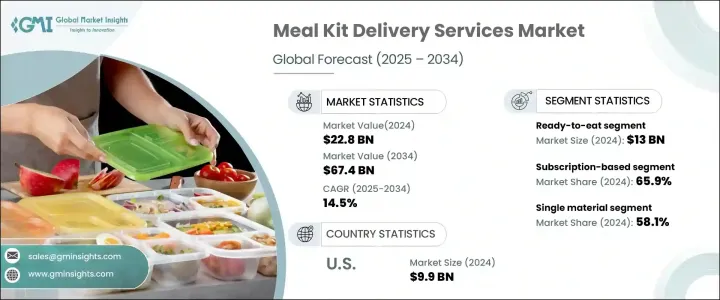
밀 키트 배달 서비스 시장은 2024년에 228억 달러로 평가되었으며 2025년부터 2034년까지 연평균 복합 성장률(CAGR) 14.5%를 나타낼 것으로 예측됩니다.
편리하고 분량이 관리되고 영양 균형 잡힌 식단에 대한 수요 증가가 이 성장을 뒷받침하고 있습니다. 현대의 라이프 스타일은 점점 더 빠르고 소비자는 맛과 건강상의 이점 모두 미래 키트는 편의성과 영양의 이상적인 균형을 제공하며, 바쁜 전문가부터 건강 지향적인 가족까지 폭넓은 지우기 소비자에게 호소합니다. 또한 건강한 식습관과 식생활 환경에 대한 의식이 높아짐에 따라 피트니스 목표와 라이프 스타일 선택에 따라 밀 키트 옵션을 모색하는 개인 증가가 촉진됩니다. 세계 각국의 요리, 식물 유래의 식사, 알레르기에 배려한 식사 등 다양한 옵션이 퍼지고 있는 것도 이러한 서비스의 매력을 더욱 높여 시장의 성장에 크게 기여하고 있습니다.

밀 키트 서비스는 2024년에 시장을 독점하여 130억 달러를 기록했고 2025년부터 2034년에 걸쳐 CAGR 14.3%를 나타내 강력한 기세를 유지할 것으로 예상됩니다. 냉동 및 사전 조리된 식품의 인기가 높아짐에 따라 전통적인 가정식 옵션 대신 기성품 솔루션을 선택하는 사람들이 늘고 있습니다. 전 세계적으로 가처분 소득 수준이 높아지면서 소비자들은 시간을 절약하면서 고품질의 맛과 영양을 제공하는 가정 간편식에 더 기꺼이 투자하고 있습니다.
| 시장 범위 | |
|---|---|
| 시작 연도 | 2024년 |
| 예측 연도 | 2025-2034년 |
| 시작 금액 | 228억 달러 |
| 예측 금액 | 674억 달러 |
| CAGR | 14.5% |
밀 키트 배달 시장의 비즈니스 환경은 주로 구독형과 온디맨드형으로 나뉘어져 있습니다. 고객의 다양한 요구에 부응하는 고급 AI 주도의 개인화 도구는 과거의 식사 선택을 분석하고 개인의 식사 요구 사항에 맞는 식사를 권장함으로써 고객 경험을 더욱 향상시켜 줍니다.
미국의 밀 키트 배달 서비스 시장은 2024년에 99억 달러로 평가되었고 소비자의 기호의 변화가 그 원동력이 되고 있습니다. 또한 환경에 대한 관심이 높아짐에 따라 기업에게 친환경 패키징 솔루션을 채택하고 식품 폐기물을 최소화하는 전략을 시행하고 있습니다. 한편, 아시아태평양은 예측 기간 중에 가장 급속한 성장을 이룰 전망입니다. 조리된 식품 솔루션에 대한 투자 의욕을 높이고 있기 때문입니다. 이와 같이 여러 지역에서 수요가 급증하고 있는 것은 세계의 밀 키트 서비스 매력과, 가정의 식탁의 미래를 재구축할 가능성을 부각하고 있습니다.
The Global Meal Kit Delivery Services Market was valued at USD 22.8 billion in 2024 and is projected to grow at a CAGR of 14.5% between 2025 and 2034. The growing demand for convenient, portion-controlled, and nutritionally balanced meals is a key factor fueling this growth. As modern lifestyles become increasingly fast-paced, consumers are actively seeking hassle-free food solutions that offer both taste and health benefits. Meal kits provide an ideal balance between convenience and nutrition, appealing to a wide range of consumers-from busy professionals to health-conscious families. Moreover, rising awareness of healthy eating habits and dietary preferences is encouraging more individuals to explore meal kit options that align with their fitness goals and lifestyle choices. The expanding variety of global cuisines, plant-based meal options, and allergy-conscious alternatives further widens the appeal of these services, contributing significantly to market growth.

Meal kit services fall into two main categories: ready-to-cook and ready-to-eat. The ready-to-eat segment dominated the market in 2024, generating USD 13 billion, and is expected to maintain strong momentum, growing at a CAGR of 14.3% from 2025 to 2034. The growing inclination toward convenience foods, driven by time constraints, has made ready-to-eat meal kits a preferred choice for consumers who prioritize ease of preparation. With the increasing popularity of frozen and pre-cooked meals, more individuals are opting for ready-made solutions over traditional home-cooked options. As disposable income levels rise globally, consumers are more willing to invest in prepared meals that save time while delivering high-quality taste and nutrition.
| Market Scope | |
|---|---|
| Start Year | 2024 |
| Forecast Year | 2025-2034 |
| Start Value | $22.8 Billion |
| Forecast Value | $67.4 Billion |
| CAGR | 14.5% |
The operational landscape of the meal kit delivery market is primarily divided between subscription-based and on-demand models. Subscription services accounted for 65.9% of the market share in 2024, owing to their user-friendly interfaces and personalized options. These plans offer the flexibility to choose meal preferences, modify portion sizes, or skip deliveries as needed, catering to the diverse needs of consumers. Advanced AI-driven personalization tools have further enhanced the customer experience by analyzing previous food choices and recommending meals that align with individual dietary requirements. The continuous advancement of technology in the meal kit space is helping brands strengthen customer loyalty and satisfaction.
In the United States, the meal kit delivery market was valued at USD 9.9 billion in 2024, driven by shifting consumer preferences. The increasing popularity of remote work has heightened interest in convenient meal solutions, fostering sustained industry growth. Furthermore, rising environmental concerns have prompted companies to adopt eco-friendly packaging solutions and implement strategies to minimize food waste. The emphasis on sustainability is becoming a crucial differentiator in the market, influencing purchasing decisions and brand perception. Meanwhile, the Asia Pacific region is poised to experience the fastest growth during the forecast period, as consumers in countries such as China and India show an increasing willingness to invest in pre-cooked meal solutions that offer convenience and variety. This surge in demand across multiple regions highlights the global appeal of meal kit services and their potential to reshape the future of home dining.